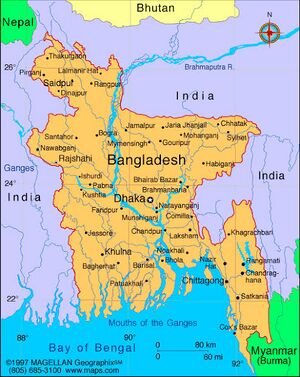Kamata
| Author:Laxman Burdak, IFS (R) |

Kamata (कमता) was a capital of Samatata kingdom, 12 miles west of Comilla district in Bangladesh. Kamarupa was reorganized as a new state, 'Kamata' by name with Kamatapur as capital.
Origin
Variants
- Kamata (कमता) (बांग्लादेश) (AS, p.137)
- Karamata (करमत) (AS, p.137)
- Karmmanta (करमंत)
- Karmanta (कर्मांत) = Badkant (बड़कंत) (जिला कोमिल्ला, बांग्लादेश) (AS, p.146)
- Badkanta/Badkant /Badakanta बड़कंत दे. Karmanta कर्मान्त (AS, p.603)
- Bad-Kamata (बड़कामत)
- Kamatapur (कमतापुर)
- Kamatapura (कमतापुर)
- Karumanta (करुमन्त) (बांग्लादेश) (AS, p.141)
History
The Kamata kingdom appeared in the western part of the older Kamarupa on the Indian subcontinent in the 13th century, after the fall of the Pala dynasty.
Kamarupa was reorganized as a new state. 'Kamata' by name with Kamatapur as capital. The exact time when the change was made is uncertain. But possibly it had been made by Sandhya (c1250-1270) as a safeguard against mounting dangers from the east and the west. Its control on the eastern regions beyond the Manah (Manas river) was lax. [1]
The rise of the Kamata kingdom marked the end of the ancient period in the History of Assam and the beginning of the medieval period. The last rulers were the Khens, who were later displaced by Alauddin Hussain Shah, the Turko-Afghan ruler of Gauda. Though Hussain Shah developed extensive administrative structures, he could not maintain political control and the control went to the Koch dynasty.
The Koches called themselves Kamateshwaras (the rulers of Kamata), but their influence and expansions were so extensive and far-reaching that their kingdom is sometimes called the Koch Kingdom. In the same century the kingdom split in two: Koch Bihar and Koch Hajo. The eastern kingdom, Koch Hajo, was soon absorbed into the Ahom kingdom in the 17th century. The western portion of the Kamata kingdom, Koch Bihar, continued to be ruled by a branch of the Koch dynasty and later merged with the Indian territory after the independence of India from the British domain.[2]
Tej Ram Sharma[3] writes that.... Epigraphical evidence shows that Samatata comprised the districts of Comilla, Noakhali and Sylhat. [4] Its capital Karmmanta has been identified with Bad-Kamata, 12 miles west of Comilla district. [5] After the rule of the Guptas, Samatata was successively under the Khadga, Candra, Varman and Sena dynasties. [6]
कमता
विजयेन्द्र कुमार माथुर[7] ने लेख किया है ...कमता (AS, p.137) वर्तमान में पूर्वी बांग्लादेश के कोमिल्ला से बारह मील की दूरी पर स्थित हैं। यहाँ पालवंशीय नरेशों के शासन काल (10वीं-11वीं शती) के अनेक बौद्ध अवशेष-मूर्तियां आदि प्राप्त हुए हैं। उस समय कमता या करमत में समतट प्रदेश की राजधानी थी।
कर्मांत
विजयेन्द्र कुमार माथुर[8] ने लेख किया है ...कर्मांत = बड़कंत (जिला कोमिल्ला, बांग्लादेश) (AS, p.146): कर्मांत गुप्तकाल में संभवत: समतट प्रदेश की राजधानी कर्मांत (वर्तमान बड़कंत) नामक नगर में थी। समतट का उल्लेख समुद्रगुप्त की प्रयाग प्रशस्ति में है।
करुमंत
विजयेन्द्र कुमार माथुर[9] ने लेख किया है ... करुमन्त (बांग्लादेश) (AS, p.141): करुमंत पूर्वी बंगाल, बांग्लादेश में स्थित प्राचीन समतट की राजधानी था। समतट में पूर्वी बंगाल अर्थात् तिपरा, नोआखली, बारिसाल, फ़रीदपुर और ढाका ज़िले सम्मिलित थे। (देखें भट्टसाली- ए फॉरगाटन किंगडम आफ ईस्टर्न बंगाल, पृ 85-91)
10वीं शती में इस प्रदेश में अराकान के चंद्रवंशीय नरेशों का राज्य था।
External links
References
- ↑ Sarkar, J. N. (1992), "Chapter II The Turko-Afghan Invasions", in Barpujari, H. K., The Comprehensive History of Assam, 2, Guwahati: Assam Publication Board, pp. pp. 40–41
- ↑ http://coochbehar.nic.in/htmfiles/royal_history2.html
- ↑ Personal and geographical names in the Gupta inscriptions/Place-Names and their Suffixes ,p. 261
- ↑ Kielhorn, (ed.), Mahabhvsya, Vol. II, p. 298.
- ↑ 660
- ↑ Beal, Buddhist Records of the Western World. Vol. II, p. 230
- ↑ Aitihasik Sthanavali by Vijayendra Kumar Mathur, p.137
- ↑ Aitihasik Sthanavali by Vijayendra Kumar Mathur, p.146
- ↑ Aitihasik Sthanavali by Vijayendra Kumar Mathur, p.141

